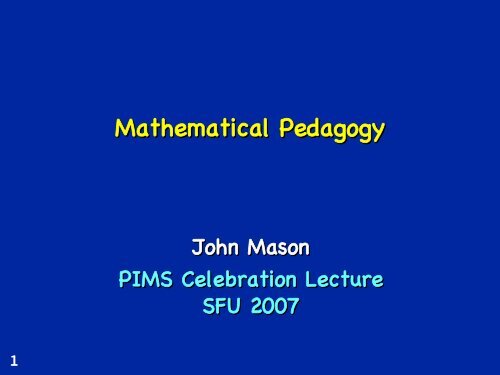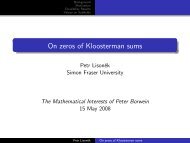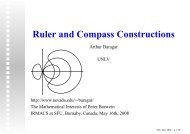Mathematical Pedagogy
Mathematical Pedagogy - IRMACS Centre
Mathematical Pedagogy - IRMACS Centre
You also want an ePaper? Increase the reach of your titles
YUMPU automatically turns print PDFs into web optimized ePapers that Google loves.
<strong>Mathematical</strong> <strong>Pedagogy</strong><br />
John Mason<br />
PIMS Celebration Lecture<br />
SFU 2007<br />
1
Definitions<br />
✏ <strong>Mathematical</strong> <strong>Pedagogy</strong><br />
– Strategies for teaching maths; useful constructs<br />
✏ <strong>Mathematical</strong> Didactics<br />
– Tactics for teaching specific topics or concepts<br />
✏ Pedagogical Mathematics<br />
– <strong>Mathematical</strong> explorations useful for, and arising<br />
from, pedagogical considerations<br />
2
Perforations<br />
3<br />
How many holes<br />
for a sheet of<br />
r rows and c columns<br />
of stamps?<br />
If someone claimed<br />
there were 228 perforations<br />
in a sheet,<br />
how could you check?
Possible Strategies<br />
✏ Watch What You Do<br />
– Specialise but attend to what your body<br />
does as way of seeing & as source of<br />
generalisation<br />
✏ Say What You See<br />
– Reveal/locate distinctions, relationships,<br />
properties, structure<br />
4<br />
Holding Wholes (gazing)<br />
Discerning Details<br />
Recognising Relationships<br />
Perceiving Properties<br />
Reasoning on the Basis of Properties
Perforations Generalised<br />
✏ Dimensions of<br />
possible variation:<br />
For Each Stamp:<br />
– number of horizontal perforations top & bottom<br />
– number of vertical perforations, left & right<br />
– number of perforations in the corners<br />
5<br />
Structural Generalisation: write down the number<br />
of perforations for R rows and C columns and<br />
characterise the numbers which can arise
Structured Variation Grids<br />
✏ Pedagogical Offshoot<br />
6
Vecten<br />
Holding Wholes (gazing)<br />
Discerning Details<br />
Recognising Relationships<br />
Perceiving Properties<br />
7Reasoning on the Basis of Properties
8<br />
Chords<br />
✏ Locus of midpoints of chords of a quartic?<br />
✏ Locus of midpoints of fixed-width chords?<br />
Chord Slopes<br />
family of chords with one end fixed: slope locus;<br />
what happens as the length goes to zero?<br />
fixed width chords: slope locus;<br />
what happens as the width goes to zero?<br />
? chords of fixed length: slope locus;<br />
what happens as the width goes to zero?<br />
? envelope of slopes of chords through pt
Cubic Construction<br />
✏ Construct a cubic for which the<br />
root-tangents are alternately<br />
perpendicular<br />
✏ It seems a reasonable task, except that it<br />
is impossible!<br />
✏ Why is it impossible?<br />
What sorts of constraints are acting?<br />
✏ What about quartics?<br />
9
Discovery<br />
✏ Suppose a cubic has three distinct<br />
real roots.<br />
✏ Then the sum of the cotangents of<br />
the root-angles is 0.<br />
✏ More generally, for a polynomial of<br />
degree d, the sum of the products of<br />
the root-slopes taken d – 1 at a time<br />
is zero.<br />
10
Extension<br />
✏ Suppose a line cuts a polynomial of<br />
degree d > 1 in d distinct points.<br />
✏ What is the sum of the cotangents of<br />
the angles the line makes with the<br />
polynomial at the intersection points?<br />
11
Cutting-Angles (1)<br />
• Let the line L(x) have slope m<br />
1<br />
cot(α) =<br />
ταν(θ − ϕ)<br />
= 1 + tan(q)tan(j )<br />
tan(q) - tan(j )<br />
= 1+ p' ( r j )m<br />
p' ( r j ) - m<br />
α = θ - ϕ<br />
QuickTime and a<br />
TIFF ( LZW)<br />
decompressor<br />
are needed to see this picture.<br />
ϕ<br />
θ<br />
α<br />
12
Cutting-Angles (2)<br />
• Put f(x) = p(x)-L(x)<br />
d<br />
• We know that 1<br />
¥ = 0 =<br />
f '(r j<br />
)<br />
1<br />
δ<br />
¥<br />
1<br />
1<br />
π∋(ρ ϕ<br />
) − µ<br />
• But the sum of the cots of the angles<br />
between line and function is<br />
δ<br />
1 + µ π∋(ρ )<br />
¥<br />
ϕ<br />
= µ ¥ 1 +<br />
π∋(ρ ) − µ ϕ<br />
1<br />
δ<br />
1<br />
δ<br />
µ 2 + 1<br />
¥ = µ δ<br />
π∋(ρ ) − µ ϕ<br />
1<br />
13
14<br />
Root-slope polynomial<br />
Given a polynomial<br />
p ρ<br />
p(x) = α<br />
κ=1<br />
( ξ − ρ ) κ<br />
Define the root-slope polynomial of p to be<br />
( ξ) = α δ ( ξ − π∋( ρ ) κ )<br />
κ=1<br />
The constant term is (-1) d times the discriminant<br />
which is the square of the product of the<br />
inter-rootal distances.<br />
δ<br />
The coefficient of x is 0, which can be thought of<br />
as the sum of the reciprocals of the root-slopes,<br />
times the product of all the root-slopes.<br />
δ
Chordal Triangles<br />
✏ Locus of centroids of chordal triangles?<br />
✏ Locus of Circumcentre of chordal triangles with<br />
fixed chord widths?<br />
✏ Locus of area of triangles with fixed chord<br />
widths?<br />
✏ Limit of circumcentres?<br />
✏ Limit of excentres of chordal triangle?<br />
✏ Limit of centre of Bevan Circle?<br />
✏ Limit of area/product of chord widths?<br />
15
16<br />
Mean Menger Curvature<br />
✏ Given three points on a curve, the<br />
Menger curvature is the reciprocal of<br />
the radius of the circle through the<br />
three points<br />
✏ Given three points on a function, they<br />
determine an interval on the x-axis.<br />
Is there a point in the interior of that<br />
interval, at which the curvature of the<br />
function is the Menger curvature of the<br />
three points?<br />
✏ Try something easier first.
Rolle-Lagrange Mean-Parabola<br />
✏ Given three points on a function but<br />
not on a straight line, there is a<br />
unique quadratic function through<br />
them.<br />
✏ Is there a point in the interval<br />
spanned, to which some point on the<br />
parabola can be translated so as to<br />
match the function in value, slope and<br />
second derivative at that point?<br />
17
18<br />
Why ‘Mean Value’?<br />
Let f be integrable on [a, b].<br />
The average (mean) value of f on [a, b] is<br />
b<br />
a<br />
f<br />
β− α<br />
✏A A sensible ‘Mean Value’ property (MVP):<br />
There exists c in [a, b] for which f = f(c) (b - a)<br />
✏ The usual ‘Mean Value’ Theorem(s) then<br />
become<br />
– Derivatives (being continuous) satisfy the<br />
MVP on every subinterval<br />
– Integrals of continuous functions satisfy the<br />
MVP on every subinterval<br />
b<br />
a
Mean Menger Curvature<br />
Given a circle through three points (Menger circle), is there a<br />
point on the spanned interval with the same curvature?<br />
Suppose f and g are both twice differentiable on [a, b],<br />
that k(f) < k(g) on [a, b], and that f(a) = g(a).<br />
If f (a)<br />
g (a) then<br />
for all x in (a, b],<br />
f(x) g(x):<br />
QuickTime and a<br />
TIFF (Uncompressed) decompressor<br />
are needed to see this picture.<br />
QuickTime and a<br />
TIFF (Uncompressed) decompressor<br />
are needed to see this picture.<br />
QuickTime and a<br />
TIFF (Uncompressed) decompressor<br />
are needed to see this picture.<br />
QuickTime and a<br />
TIFF (Uncompressed) decompressor<br />
are needed to see this picture.<br />
QuickTime and a<br />
TIFF (Uncompressed) decompressor<br />
are needed to see this picture.<br />
QuickTime and a<br />
TIFF (Uncompressed) decompressor<br />
are needed to see this picture.<br />
If g has constant curvature (is part of a circle) and<br />
k(f) ≠ k(g) on [a, b] then f and g can intersect<br />
at most twice.<br />
19<br />
If f (a)<br />
g (a) th en<br />
for at most one x in<br />
(a, b],<br />
f (x) = g(x).<br />
Therefore there must<br />
be a point s on [a, b]<br />
at which<br />
k(f(s)) = Menger Curvature<br />
of the points a, b, c.
Cauchy Mean Value Theorem<br />
Augustin Cauchy 1789-1857)<br />
✏ Let [ [f(t), g(t)] ] trace a differentiable<br />
curve in the plane<br />
– in each interval [a,[<br />
b] ] there exists a<br />
point s at which<br />
[g(b) – g(a)] g<br />
f’(s) = [f(b) – f(a)] f<br />
g’(s)<br />
20
Cauchy Mean Menger Curvature?<br />
Is there a Cauchy version of curvature<br />
for curves in the plane?<br />
NO!<br />
Counter Example:<br />
QuickTime and a<br />
TIFF ( Uncompressed ) decompressor<br />
are needed to see this picture.<br />
2 +t 2<br />
( 1 +t 2<br />
) 3/ 2<br />
QuickTime and a<br />
TIFF ( Uncompressed)<br />
decompressor<br />
are needed to see this picture.<br />
21
22<br />
Procedural-Instrumental<br />
Conceptual-Relational<br />
✏ Human psyche is an interweaving of<br />
behaviour (enaction)<br />
emotion (affect)<br />
awareness (cognition)<br />
✏ Behaviour is what is observable<br />
✏ Teaching:<br />
transposition<br />
– Expert awareness is transposed<br />
didactique<br />
into instruction in behaviour<br />
– The more clearly the teacher indicates<br />
the behaviour expected,<br />
the easier it is for learners to display it<br />
without generating it<br />
from and for themselves<br />
didactic tension
Tasks & Teaching<br />
✏ Tasks are only a vehicle for engaging in<br />
mathematical thinking<br />
✏ Learners need to be guided, directed,<br />
prompted, and stimulated to make sense<br />
of their activity: to reflect<br />
– To manifest a reflection geometrically as a<br />
rotation, you need to move into a higher<br />
dimension!<br />
– The same applies to mathematical thinking!<br />
23
24<br />
Pedagogical Mathematics<br />
✏ ‘Problems’ to explore probe learner<br />
awareness and comprehension, and afford<br />
opportunity to use their own powers to<br />
experience mathematical thinking<br />
✏ These may not be at the cutting edge;<br />
✏ Often they may be hidden in the<br />
undergrowth of mathematics of the past<br />
✏ but they can be intriguing!<br />
✏ Effective teaching of mathematics results<br />
in learners with a disposition to explore<br />
for themselves.
Further Reading<br />
Mathem atics Teaching Practice:<br />
a guide for university and college<br />
lecturers,<br />
Horwood Pu blish in g. Mason J. (2002).<br />
Mathem atics as a Constructive Activity:<br />
learners generating exam ples.<br />
Erlbau m . Watson A. & Mason J. (2005).<br />
Counter- Exam ples in Calculus.<br />
m an u scrip t, Klym ch u k, S. & Mason , J.<br />
25<br />
http://mcs.open.ac.uk/jhm3






